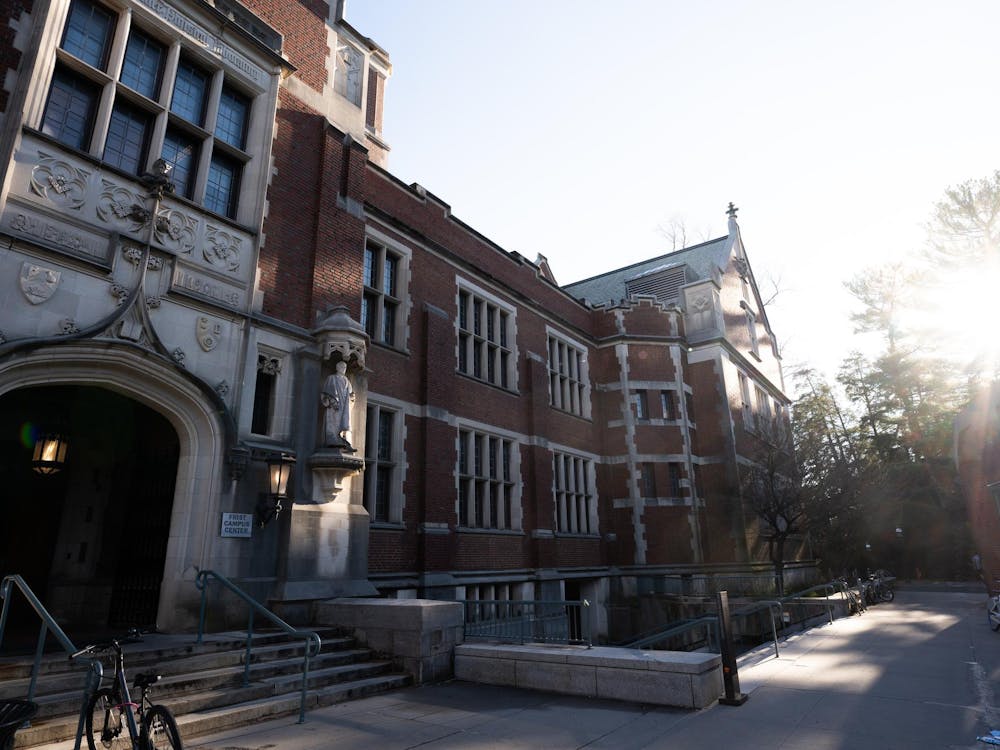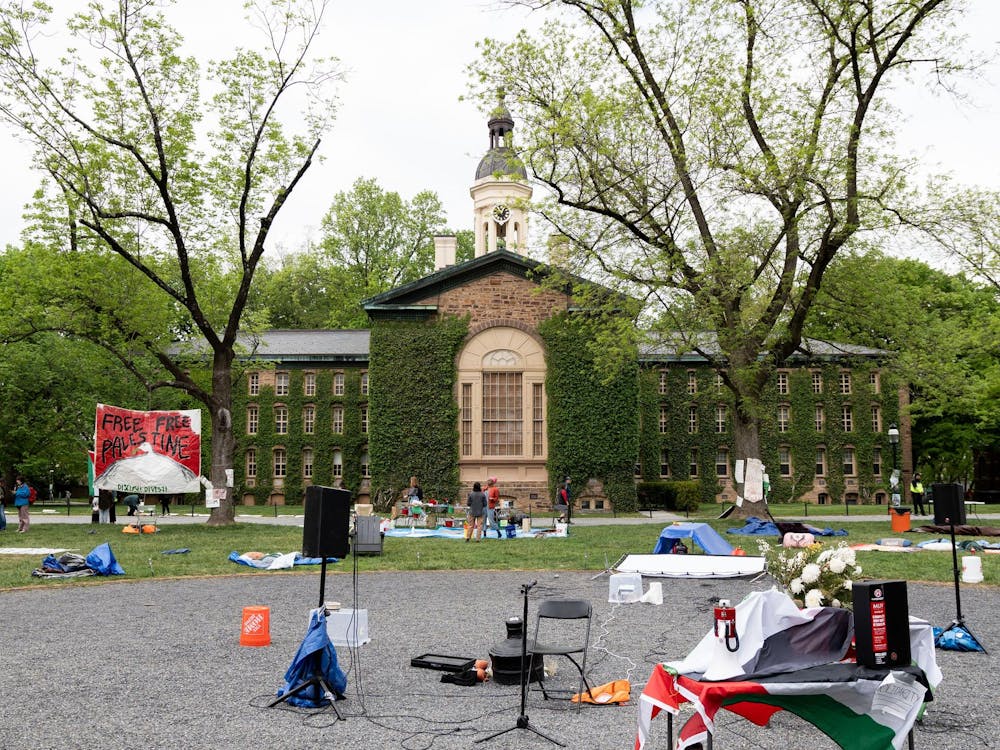Designed by renowned architect Frank Gehry, the new 87,000-square-foot building now houses the astrophysics, biology, chemistry, mathematics, physics, statistics and geosciences and map collections, all of which were formerly scattered around campus.
The bold style of the building, whose massive sloping planes of sheet metal stand apart from the traditional neo-Gothic designs that pervade campus, aims to be an emblem of the University’s mission of innovation and creativity.
“As a university that aspires to do everything at the highest possible level, we should be building buildings that the great architects of today are interested in designing,” President Tilghman said in an interview.
“We are a university that lives on the boundary between great traditions, which we adore, and being on the forefront of discovery,” she said. “We study Chaucer and at the same time we study Toni Morrison. We don’t see that there is a contradiction there. I feel the same is true about this campus and architecture as an art form.”
Nestled between Fine Hall and Ivy Lane, the library is named for University trustee Peter Lewis ’55, who announced a $60 million donation in 2001 to fund a new science library. Lewis is chairman of the board of the automobile insurance company Progressive Corp.
Lewis said in an interview that his motivation for the donation was not only “a strong desire and an interest in supporting Princeton” but also “a feeling that having a building designed by Gehry would make Princeton a better campus.”
Gehry’s style, he explained, is “unique” and “challenging,” and Gehry himself is a “masterful user of technology.” He added that he and Gehry are “very good friends.” The design is characteristic of other Gehry buildings such as the Guggenheim Museum in Bilbao and the Walt Disney Concert Hall.
“We chose an embossed finish on this metal to give it a soft glow,” Craig Webb ’74, a design partner at Gehry Partners who worked on the project, said in an e-mail. “This finish picks up the color of the surroundings, the green of the trees and the blue of the sky.”
The library is the newest, and perhaps most prominent, addition to the cluster of science and technology buildings south of Prospect Avenue on Washington Road. Several more buildings, including the chemistry, psychology and neuroscience buildings, are slated to be built in the next few years.
“The Gehry design provides a gateway to our modern campus east of Washington Road,” former University architect Jon Hlafter ’61 said in an e-mail.
Starting today, the library’s regular academic session hours will be 8:30 a.m. to 2 a.m. on Mondays through Thursdays, 8:30 a.m. to midnight on Fridays, 9 a.m. to midnight on Saturdays and 9 a.m. to 2 a.m. on Sundays.
A dedication ceremony for the Lewis Library will be held Nov. 20.

A virtual tour
With its tangle of downward-curving roof extensions and multilevel sections, the Lewis Library can seem intimidating at first glance.
The main portion consists of a tower with four stories above-grade. A wing along Ivy Lane has three stories above-grade, and a wing along Washington Road has two stories above-grade. The tower reaches more than 100 feet, making it about half as tall as its neighbor, Fine Hall. The library also includes one below-grade level that connects to the Fine Hall Library.
“The massing steps up to the south, creating a transition from the residential scale up to the much taller Fine tower,” Webb said. “Our intent in this stair-stepping is to make a better neighbor of the tower.”
Stepping inside, visitors are greeted by the jade, lime-green, cerulean and bright-orange walls surrounding the building’s atrium, which starts in a limestone-paved lobby on the 100-level and extends upward into the library’s tower.
“We are very interested in painting and [the] like to bring those issues into our design,” Webb said. “The colors are placed so that they reflect and color other walls next to them that have no color of their own: borrowed color. The lobby will be an exciting space as a transition to the calmer spaces further in the building.”
Many of the interior furnishings carry a raw plywood look, and the pillars are also unfinished columns of concrete.
Branching off the lobby is a 100-level entrance to the library; five classrooms; a seminar room; a new media lab; and what Henry Thomas, project manager in the Office of Design and Construction, described as a “vending area” with modern white tables and chairs and a cove, where caterers could potentially set up tables when holding future events.
Untraditional shapes pervade the new building, such as an opening in the shape of a curved six-pointed star through which patrons on the 200-level of the library can look down on the 100-level. End tables designed by Gehry scattered throughout the library’s study areas also offer a departure from the ordinary, which, despite their gray color, stand out because of their rounded and oblique shapes.
One of the Lewis Library’s most memorable features is what Gehry dubbed the “treehouse,” a spacious room on the 200-level dominated by windows looking out onto the plethora of trees along Washington Road.
The room contains nine square wooden tables, with long, thin cylindrical lights hanging above like floating candles or illuminated stalactites.
“When the use of the room was changed, the lighting needed to be reconceived,” Webb said. “The vertical expression on the fixtures emphasizes the height of the room and leads the eye upward.”
A new face to campus architectural diversity
The University has taken on modern and postmodern design projects in the past, most notably Spelman Halls, designed by I.M. Pei, Robertson Hall, designed by Minoru Yamasaki, and Carl Icahn Laboratory, designed by Rafael Vinoly.
But the Gehry building, with its curved steel roof extensions and quirky interior features, is arguably the most unconventional on campus.
“I think what [the library] says is that this 262-year-old institution is looking to embrace different types of architectural design,” Tilghman said. “Even if you look at central campus, there is no overriding style.”
She noted Cannon Green as an example of a place containing diverse architectural styles, including Victorian Gothic, Georgian and Greek revival.
Princeton will never be like the University of Virginia, where a single, classical architectural language has been adopted, Tilghman explained. “We are looking to build some of the greatest buildings of today, and if you look the great architects of our time, Gehry is in [the] top five.”
Hlafter said he hoped that the “Lewis Library, together with other campus buildings, will help students appreciate the diverse richness and variety of architecture, now and when they leave Princeton.”
Technological powerhouse
The library has desktop workstations on every floor, with a nearly even ratio of Mac to PC desktops. Additionally, the technology hub will occupy the three-story Ivy Lane Wing.
OIT is using the library to consolidate two of its major academic technology support groups, the Education Technologies Center and the New Media Center, OIT Associate Chief Information officer Serge Goldstein said.
The 100-level of the Lewis Library will also become home to a New Media Center with more than twice as much floor space as the old facility. The space will be used for workstations with software and hardware for creating and manipulating images, movies and other digital objects.
“All in all, we are scaling up our level of support and expanding the number of workstations to handle more demand,” Goldstein said.
“One of things we are looking to do a lot more of is work with video,” he explained. He added that the Lewis Library is “opening the first full-function audio and video broadcast center” on its A-level.
The New Media and the broadcast centers will offer training, and OIT is currently looking to hire more tech-savvy students for new training positions.
“The way in which scientists interact with libraries has radically changed in the last 15 or so years,” Tilghman noted. She explained that as a researcher, she used the library extensively before the internet expanded to provide her with most of the information she needed.
“The Lewis Library represents a ground-shift in library design,” she said.
New spaces for learning
The library “provides students with bright, inspirational spaces to study and work, to work together in groups, to collaborate with faculty, and to consult outstanding print and electronic collections in the sciences,” Patricia Gaspari-Bridges, the head librarian for the Lewis Library, said in an e-mail.
The “merged collections, resources and staff perfectly reflects the interdisciplinary nature of science,” she said.
Gaspari-Bridges said that all of the collections that the library is currently scheduled to hold were transferred into Lewis Library from their former locations over the course of seven weeks this summer.
“All of those smaller libraries that were in very expensive laboratory buildings can be renovated and turned into laboratory space, which many of the departments need,” Tilghman explained.
The new library’s primary print collections are shelved on the A-level of the Lewis Library and in the Fine Hall Wing, Gaspari-Bridges said. The 100-level section of the library contains the main circulation desk, the reference books and the more recently published works.
The 200-level contains the unbound periodicals. The 300- and 400-levels are mostly devoted to study tables, group study rooms and seminar rooms.
Though the Psychology Library remains in Green Hall, its collections will move to Lewis Library once the new psychology and neuroscience buildings are complete.
In total, six librarians and 14 administrative and support staff are moving into the new building from the merging libraries. The Lewis Library will also hire about 60 student workers.








